 Oceanic Submersibles: 1939-40: Console Generale Liuzzi, Alpino Bagnolini, Reginaldo Giuliani, Capitano Tarantini.
Oceanic Submersibles: 1939-40: Console Generale Liuzzi, Alpino Bagnolini, Reginaldo Giuliani, Capitano Tarantini.WW2 Italian Submarines
Balilla class (1927) | Ettore Fieramosca (1929) | Archimede class (1933) | Glauco class (1935) | Pietro Micca (1935) | Calvi class (1935) | Foca class (1937) | Marcello class (1938) | Brin class (1939) | Liuzzi class (1939) | Marconi class (1940) | Cagni class (1940) | Romolo class (1943)Mameli class (1926) | Pisani class (1928) | Bandiera class (1929) | Squalo class (1930) | Bragadin class (1929) | Settembrini class (1930) | Argonauta class (1931) | Sirena class (1933) | Argo class (1936) | Perla class (1936) | Adua class (1936) | Acciaio class (1941) | Flutto class (1942)
CM class (1943) | CC class (Laid down) | CA class (1942) | CB class (1942)
The Liuzzi class were four submersibles all built by Tosi NyD in Taranto for the Regia Marina just before the war. They were an extrapolation of the Brin class design, albeit with their main gun relocated on the deck. They were completed as Italy declared war on the allies. They spent their early service time in the Mediterranean, where Liuzzi was sunk, and the remainder transferred to BETASOM, the Bordeaux-based Atlantic command later in 1940. Tarantini was sunk there but Bagnolini and Giuliani were converted as transport submarines to exchange rare trade goods with Japan, boating a cargo capacity of 160 tons, with reduced reserve buoyancy, between 20 and 25% and between 3.5 and 6% with an armament reduced. Their tally amounted to 5 freighters and a light cruiser and none survived the war.
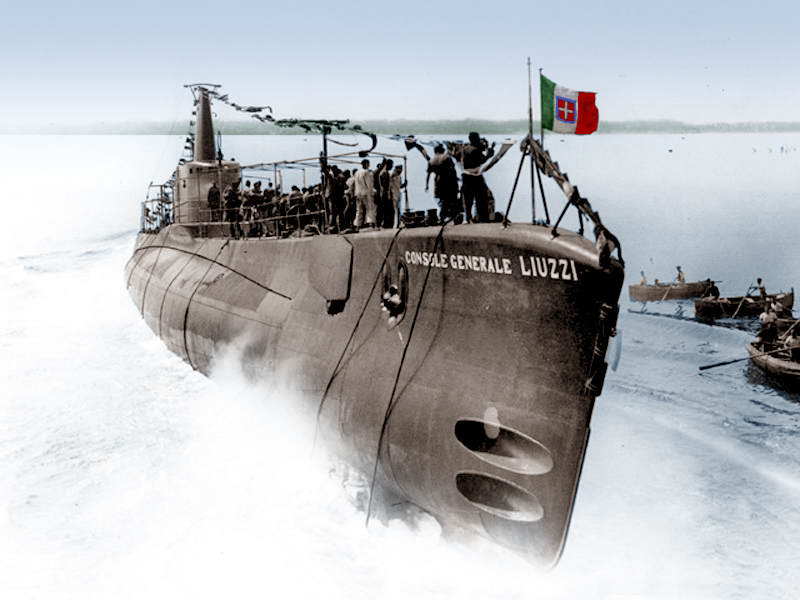
Design of the class
Development
The Liuzzi class was derived from the Brin-class oceanic submarines, with increased size and autonomy, different arrangement in artillery armament and a general appearance closer to the Marconi-class submarines. Their design still repeated some issues with the Brin class hull, notably poor longitudinal stability and poor seaworthiness in heavy weather. However overll, they were a better design, and proved to be among the best Regia Marina submarines of the interwar, still. They were at their core an increased version of the Brin class in size and partially double-hulled and still a better stability and at the expense of new bow shape for higher speed that was not at ease in heavy weather. But the biggest extrenal change was the main gun, located in the conning tower previousy, it was moved back on the deck forward, placed on a bandstand flush with the hull.
About the names:
The lead boat was named after Alberto Liuzzi (1898–1937), console generale (brigadier general) of the Blackshirts.
Attilio Bagnolini was an Alpini, fallen in combat in East Africa on 31 March 1936.
The third boat honored the memory of Father Reginaldo Giuliani, a military cleric fighting in trenches with the Arditi, 3rd Army in WWI, awarded two bronze medals and one silver medal for gallantry.
Captain Tarantini was named after Raffaele Tarantini (1895-1936) a soldier awarded the gold medal, four silver medals for gallantry as a pilot in WWI, which died in east Africa.
Hull and general design
The Liuzzi were ocean-going submersibles (in the Italian documentation it is traduced as “large (submarine) cruisers”). They had the typical partial double hull and measured 76.1 meters long overall with 6.98 meters wide so a ratio of 1/11, and draft of 4.55 meters. The displacement, when surfaced amounted to 1,166 tons (1,030 long tons (1,047 t) surfaced and 1,484 long tons (1,508 t) submerged. They could dive at no more than 100 meters (330 ft). The crew comprised 7 officers as well as 51 petty officers and sailors.
Powerplant
The propulsion system was conventional, with two Fiat-Tosi diesels used for surface navigation, for a total output of 3,420 hp, and two electric engines capable of 1,250 hp for underwater travel. Top speed in surface was 17.8 knots, only achieved during trials. Service speed was below 17 knots, and degraded fast in heavy weather. In immersion they could reach 8 knots. Total range at cruise speed at 8 knots while surfaced was 13,204 miles, which was excellent compared to the average U-Boat, but it dropped down to 3,401 miles at 17 knots. While underwater they still can approach their preys over 111 miles at 4 knots. The crossing of Gibraltar or the cape was done that way.
Armament
The artillery repeated the new 100mm/47 Mod. 1938 gun seen on the brin class, albeit at first due to shortages, they started service with the older 102/35 Mod. 1914 replaced when the new modello 1938 became available. The choice to relocate the gun, compared to the Brin class where it was at the rear conning tower into a singular “turret” with full traverse in the CT was the realization this system had also severe drawbacks. Instead, there were still two twin Breda 13.2 mm Mod. 31 heavy machine guns for anti-aircraft defence in the CT aft platform. The torpedo armament was the same as before, eight 533 mm torpedo tubes, four fixed at the bow, four fixed at the stern, all reloaded internally.
Cannone da 100/35 Mod. 1914 (Fitted in 1940)
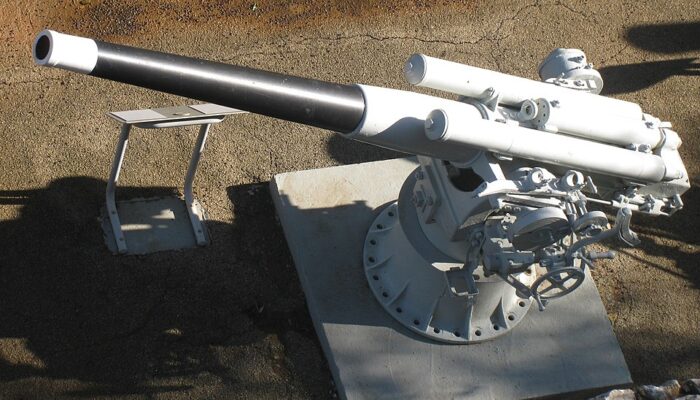
Fitted at completion due to shortages, but replaced by the modello 1938 as soon as it was available.
Specs 100 mm/35 (3.9″) Model 1914
Weight 1,220 kg (2,690 lb), barrel 3.73 m (12 ft 3 in) 35 Caliber
Shell: 15 kg (33 lb) 102 x 649mm R 102 mm (4 in)
Breech: Vertical sliding block
Elevation: -5° to +45°
Rate of fire; 7 rpm
Muzzle velocity: 755 m/s (2,480 ft/s)
Effective range: 11.7 km (7.3 mi) at +45°
Cannone da 100/47 Mod. 1938
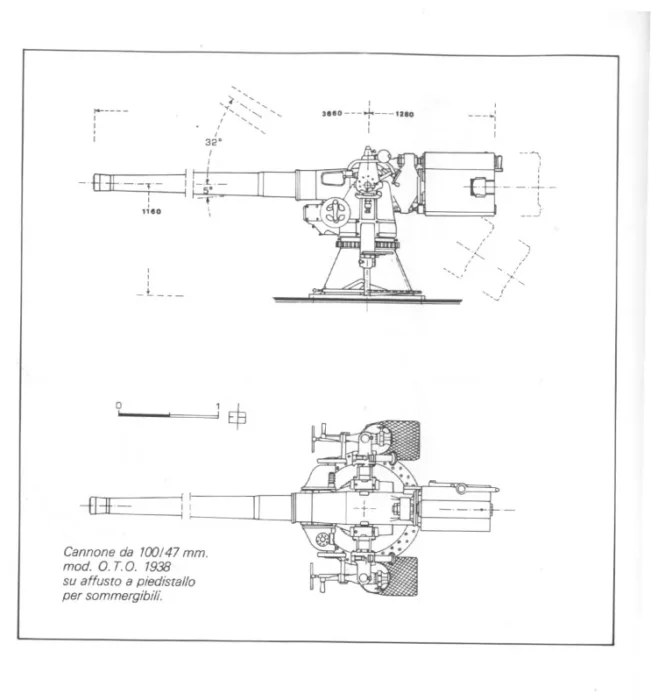
Placed on the forward deck, on a raised platform or bandstand well integrated into the hull, acting as wave breaker, to avoid sea spray. This 100 mm/47 (3.9″) Modello 1938 benefited from developments and improvements made on the earlier Modello 1928, specifically intended for submarines but also used on a few auxiliary vessels, all manufactured by OTO. The Modello 1931, 1935 and 1938 for Subsmarines were present on the the Glauco, Marcello, Cappellini, Liuzzi, Marconi, Cagni, Sirena, Perla, Adua, Argo, Acciaio and Flutto classes.
Specs
Gun Length oa: 194.5 in (4.940 m), 8-10 rpm.
Fixed Ammunition (HE) 30.4 lbs. (13.8 kg) 2,756 fps (840 mps)
Range: 35° 13,800 yards (12,600 m), OTO 1932
Weight 4.6 tons (4.7 mt) -5 /+32 or 35°.
To compare the previous Cannone da 100/43 modello 1927 had the following specs:
170 in (4.300 m) long, 8-10 rom. HE shells: 30.4 lbs. (13.8 kg), muzzle Velocity 2,625 fps (800 mps)
Elevation -5/+35°. Range: 30.4 lbs. (13.8 kg) HE Elevation/35° 12,000 yards (11,000 m).
AA: 2×2 Breda Breda Mod. 31
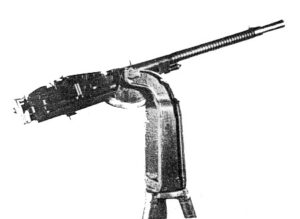
The anti-aircraft defence counted on two twin Breda M1931 13.2 mm L/76 heavy machine guns, placed aft of the conning tower. Each mount weighed 695 kg, but ensured an elevation of -10° to 90°. They fired 125 g unitary rounds, with a muzzle velocity of 790 m/s, maximum range of 6,000 meters and effective range of 2,000 meters. Their rate of fire was 500 rounds/min, so 2000 rounds when both twin mounts fired in concert, however.
14x 533 mm (21 inches) torpedoes
Models available in 1939:
-W 270/533.4 x 7.2 Veloce: 1,700 kg, 7.2 m WH 270 kg, 3,000-4,000 m/50 knots or 12,000 m/30 knots.
-W 270/533.4 x 7.2 “F”: 1,550 kg, 6.500 m, WH 250 kg, speed 3,000 m/43 knots or 10,000 m/28 knots
-W 250/533.4 x 6.5: 1,550 kg, 7.200 m, WH 270 kg, 4,000 m/48 knots or 12,000 m/30 knots.
-Si 270/533.4 x 7.2 “I”: 1,700 kg, 7.2 m, WH 270 kg, speed 3 km/42 kts or 7 km/32 kts, 9,2km/30 knots, 12km/26 kts
-W 250/533.4 x 6.72: 7.2m, WH 270 kg speed 4km/49 kts or 8km/38 kts.
-Si 270/533.4 x 7.2 “M”: 1,7 ton, 7.2 m, WH 270 kg speed 4km/46 kts, 8km/35 kts or 12km/29 kts.
They were also given also a pair of hydrophones.
⚙ specifications |
|
| Displacement | 1,030 long tons surfaced, 1,484 long tons submerged |
| Dimensions | 253 x 25 x 14 ft (77 x 7.6 x 4.3 m) |
| Propulsion | 2× 1750 hp Tosi diesels, 2x CRDA electric engines |
| Speed | 18 kts (21 mph; 33 km/h) surfaced, 8 kts (9.2 mph; 15 km/h) submerged |
| Range | 13,204 nm (24,500 km) |
| Armament | 8× 533 mm TTs (4 bow, 4 stern), 2× 100 mm/47, 2×2 13.2 mm HMG |
| Test depth | 100 m (330 ft) |
| Crew | 50 |
Modifications
In 1943, Alpino Bagnolini and Reginaldo Giuliani were converted to transports of ammunition, petrol and rare goods exchanged between Japan and Germany. They lost their torpedoes (the tubes were kept, still), main gun, but kept their AA heavy Breda machine guns in the CT. The space freed in the forward and rear torpedo compartments and sacrifice of some living quarters enabled to reach a storage area large enough to store up to 160t of payloads. Items side was dictated by the size of the hatches.
Career of The Liuzzi Class
 Console Generale Liuzzi
Console Generale Liuzzi
 Console Generale Liuzzi was launched 17 September 1939. She was lost on her first patrol. On 16 June 1940 she left Taranto under command of Lieutenant Commander Lorenzo Bezzi, and sailed to her intended ambush area off Famagusta, preying on vessels between Cyprus, Syria and Egypt. She patrolled her for five days there without any sighting. By the evening of the 25th she was thus on her way back when at 18:30 on the 27th she spotted “Force C” underway. She tried to report their position but this was likely intercepted or she was spotted by an aircraft in patrol. Whatever the cause, she was soon hunted down by the escorting destroyers, depht charged, notably by the destroyers Dainty, Defender and Ilex as reported postwar, and the latter had at the time the best and most modern sonars in the Royal Navy.
Console Generale Liuzzi was launched 17 September 1939. She was lost on her first patrol. On 16 June 1940 she left Taranto under command of Lieutenant Commander Lorenzo Bezzi, and sailed to her intended ambush area off Famagusta, preying on vessels between Cyprus, Syria and Egypt. She patrolled her for five days there without any sighting. By the evening of the 25th she was thus on her way back when at 18:30 on the 27th she spotted “Force C” underway. She tried to report their position but this was likely intercepted or she was spotted by an aircraft in patrol. Whatever the cause, she was soon hunted down by the escorting destroyers, depht charged, notably by the destroyers Dainty, Defender and Ilex as reported postwar, and the latter had at the time the best and most modern sonars in the Royal Navy.
Badly damaged, Liuzzi surfaced, but did not surrendered, instead the crew manned the main gun and started firing. This was in rough sea, and Liuzzi rock hard. Gunners were unable to aim, also blinded by sea spray. With their tall forecastle the British destroyers closed in for the kill and hit Liuzzi a dozen times with their main guns. Soon there were 9 deaths among the crew, a midshipman, sergeant and seven sailors and she was soon out of action. Captain Bezzi ordered to scuttle the boat and abandon her soon after, with all men but one rescued by the destroyers, later POWs. Commander Bezzi decided indeed to return and locked himself in, sinking with his boat, later posthumously awarded the Medaglie d’Oro. She sank around 8 pm, off the coast of Crete. Her unique patrol spanned 1695 miles surfaces, 420 submerged. Her wreck had been recovered.
 Alpino Bagnolini
Alpino Bagnolini
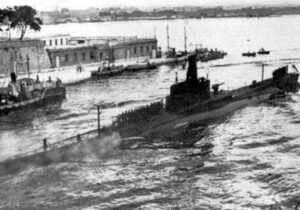 Bagnolini (pennant BI) was launched 28 October 1939, completed on 22 December 1939 and on her first patrol when war was declared. She soon stumbled upon the C class light cruiser HMS Calypso, south of Crete, on 12 June 1940. This was the best success achieved so far by any Italian submarine. In her second patrol she had no kill. After her return it was decided to sent her to the Atlantic coast, helping the Kriegsmarine against allied convoys there, thanks to their greater range. On 9 September she departed, and crossed the Strait of Gibraltar on 13 September, arrived at Bordeaux on 30 September, torpedoing underway the neutral Spanish freighter Gabo Tortosa. On her 4th patrol (1st withe BETASOM) she sank a cargo, a 3,360t freighter of convoy SC 15, but was damaged by the ASW escorts and needed repairs. Her patrols of July 1941 off Gibraltar and 18 January-22 February 1942 off the Azores were unsuccessful. Then followed three patrols to the South Atlantic (24 April-28 June, 15 September-7 November 1942,14 February-13 April 1943) with poor results. The in September they were still there, captured by Germany. The Kriegsmarine Command estimated these would be more useful as transports, converted and manned by German crews, Bagnolini sailed as UIT-22 on 26 January 1944 loaded with plans and other valuable assets for Japan. She was caught and sunk off the Cape of Good Hope by PBY Catalinas from No. 262 Squadron RAF on 11 March.
Bagnolini (pennant BI) was launched 28 October 1939, completed on 22 December 1939 and on her first patrol when war was declared. She soon stumbled upon the C class light cruiser HMS Calypso, south of Crete, on 12 June 1940. This was the best success achieved so far by any Italian submarine. In her second patrol she had no kill. After her return it was decided to sent her to the Atlantic coast, helping the Kriegsmarine against allied convoys there, thanks to their greater range. On 9 September she departed, and crossed the Strait of Gibraltar on 13 September, arrived at Bordeaux on 30 September, torpedoing underway the neutral Spanish freighter Gabo Tortosa. On her 4th patrol (1st withe BETASOM) she sank a cargo, a 3,360t freighter of convoy SC 15, but was damaged by the ASW escorts and needed repairs. Her patrols of July 1941 off Gibraltar and 18 January-22 February 1942 off the Azores were unsuccessful. Then followed three patrols to the South Atlantic (24 April-28 June, 15 September-7 November 1942,14 February-13 April 1943) with poor results. The in September they were still there, captured by Germany. The Kriegsmarine Command estimated these would be more useful as transports, converted and manned by German crews, Bagnolini sailed as UIT-22 on 26 January 1944 loaded with plans and other valuable assets for Japan. She was caught and sunk off the Cape of Good Hope by PBY Catalinas from No. 262 Squadron RAF on 11 March.
 Reginaldo Giuliani
Reginaldo Giuliani
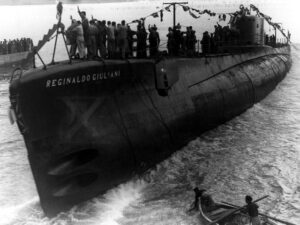 Giuliani (pennant GN) was launched 3 December 1939 and made two unsuccessful patrols before being ordered on 29 August to BETASOM. She crossed the strait of Gibraltar on 10 September and arrived in Bordeaux on 30 September the same day as her sister Bagnolini. Her first November patrol was unsuccessful.On 16 March 1941 she was ordered to the Baltic, to act as a training submarine at Gdynia, instructing Italian officers in U-Boat attack techniques and wolfpack tactics. From April 1941 to April 1942 these courses lasted between 3 and 5 weeks in the Baltic with seven Italian officers being trained eahch time. Giuliani was sent back to Bordeaux on 23 May 1942. In her 2nd patrol she sank three ships off the Cape Verde Islands, from 24 June to 3 September 1942: 10 August 1942: The 5,444th cargo ship Medon (UK). 13 August: California (US) 5,441t freighter. 14 August: British 5,218t freighter Sylvia de Larrinaga. In all, 16,103t combined. However she was hunted down and shook by several depth charge passes, and later, more severely by air attacks underway back to Bordeaux.
Giuliani (pennant GN) was launched 3 December 1939 and made two unsuccessful patrols before being ordered on 29 August to BETASOM. She crossed the strait of Gibraltar on 10 September and arrived in Bordeaux on 30 September the same day as her sister Bagnolini. Her first November patrol was unsuccessful.On 16 March 1941 she was ordered to the Baltic, to act as a training submarine at Gdynia, instructing Italian officers in U-Boat attack techniques and wolfpack tactics. From April 1941 to April 1942 these courses lasted between 3 and 5 weeks in the Baltic with seven Italian officers being trained eahch time. Giuliani was sent back to Bordeaux on 23 May 1942. In her 2nd patrol she sank three ships off the Cape Verde Islands, from 24 June to 3 September 1942: 10 August 1942: The 5,444th cargo ship Medon (UK). 13 August: California (US) 5,441t freighter. 14 August: British 5,218t freighter Sylvia de Larrinaga. In all, 16,103t combined. However she was hunted down and shook by several depth charge passes, and later, more severely by air attacks underway back to Bordeaux.
She remained in Santander until 8 November 1942 to repair damage caused by a Short Sunderland on 1 September and by a Wellington from No. 304 Sqn the following day. When she arrived she was converted as a transport submarines, a work completed in April, and she acted as a prototype to convert her sisters. She sailed out on 16 May 1943 with 130 tonnes of mercury. She managed to arrive at Singapore on 1 August 1943 and on 8 September 1943, whil still there, Japanese ally, Germany, had enough troops to seize her. Her crew was sent back home. She was renamed UIT-23 and sailed back to France on 15 February 1944, with 135 tonnes of rubber, 70 tonnes of tin. While underway, surfaced, she was spotted and torpedoed just three days in her trip, by the T-class HMS Tally-Ho. There were 14 survivors out of forty, all in the CT or close enough to escape. One was captired by Tally-Ho but the remainder were picked up by a small single engine Arado Ar 196 from Penang, and transferred on its floats, making several trips.
 Capitano Tarantini
Capitano Tarantini
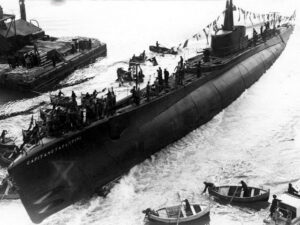 Tarantini (pennant TT) was launched 7 January 1940. She patrolled the Mediterranean by June, no results. In her second patrol she sank xxxx . This was followed by two unsuccessful patrols. She was ordred to BETASOM on 31 August 1940, crossing Gibraltar on 10 September. She had an Atlantic patrol until reaching Bordeaux on 5 October. Her first BETASOM patrol started on 11 November. She was torpedoed by HMS Thunderbolt in the Gironde estuary while back to base on 15 December 1940, surfaced. Only 5 men in her CT or deck escaped and were rescued.
Tarantini (pennant TT) was launched 7 January 1940. She patrolled the Mediterranean by June, no results. In her second patrol she sank xxxx . This was followed by two unsuccessful patrols. She was ordred to BETASOM on 31 August 1940, crossing Gibraltar on 10 September. She had an Atlantic patrol until reaching Bordeaux on 5 October. Her first BETASOM patrol started on 11 November. She was torpedoed by HMS Thunderbolt in the Gironde estuary while back to base on 15 December 1940, surfaced. Only 5 men in her CT or deck escaped and were rescued.
Read More/Src
Books
Conway’s all the world’s fighting ships 1922-46
Bagnasco, Erminio (1977). Submarines of World War Two. Annapolis, Maryland: Naval Institute Press.
Chesneau, Roger, ed. (1980). Conway’s All the World’s Fighting Ships 1922–1946. Greenwich, UK: Conway Maritime Press.
Frank, Willard C. Jr. (1989). “Question 12/88”. Warship International. XXVI (1): 95–97.
Rohwer, Jürgen (2005). Chronology of the War at Sea 1939–1945: The Naval History of World War Two (Third Revised ed.). NIP
Colombo, Lorenzo (June 18, 2024). “R.Smg. Torricelli”. regiamarina.net. Cristiano D’Adamo.
Erminio Bagnasco, Maurizio Brescia, I sommergibili italiani 1940-1943. Storia Militare n.12 2014.
Links
on marina.difesa.it/
trentoincina.it/ Liuzzi
trentoincina.it/ Bagnolini
trentoincina.it/ Tarantini
trentoincina.it/ Guiliani
it.wikipedia.org Classe_Liuzzi
xmasgrupsom.com Bagnolini.htm
uboat.net/ Liuzzi class
betasom.it classe-liuzzi-1938
sommergibili.com brin
grupsom.com
navweaps.com 100mm/43 m1927
on xmasgrupsom.com tarantini.html
on ww2db.com/
navypedia.org/ liuzzi.htm
sommergibili.com/tarantinie.htm
on uboat.net/ uit23
it.wikipedia.org Alpino_Bagnolini
Model Kits
None found so far

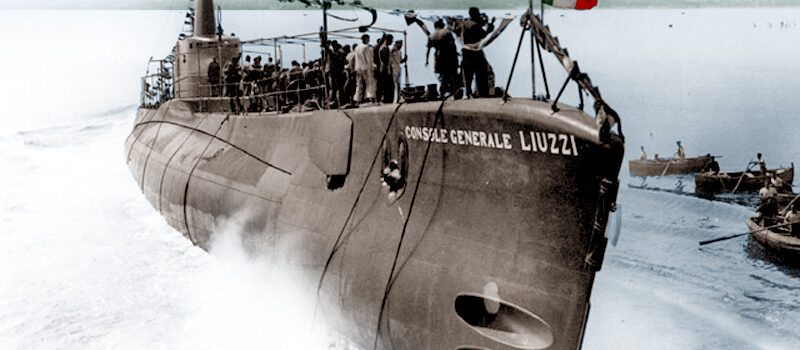
 Latest Facebook Entry -
Latest Facebook Entry -  X(Tweeter) Naval Encyclopedia's deck archive
X(Tweeter) Naval Encyclopedia's deck archive Instagram (@navalencyc)
Instagram (@navalencyc)


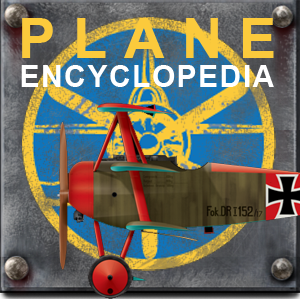
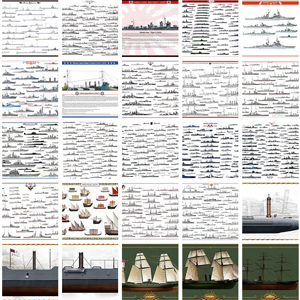

 French Navy
French Navy Royal Navy
Royal Navy Russian Navy
Russian Navy Armada Espanola
Armada Espanola Austrian Navy
Austrian Navy K.u.K. Kriegsmarine
K.u.K. Kriegsmarine Dansk Marine
Dansk Marine Nautiko Hellenon
Nautiko Hellenon Koninklije Marine 1870
Koninklije Marine 1870 Marinha do Brasil
Marinha do Brasil Osmanlı Donanması
Osmanlı Donanması Marina Do Peru
Marina Do Peru Marinha do Portugal
Marinha do Portugal Regia Marina 1870
Regia Marina 1870 Nihhon Kaigun 1870
Nihhon Kaigun 1870 Preußische Marine 1870
Preußische Marine 1870 Russkiy Flot 1870
Russkiy Flot 1870 Svenska marinen
Svenska marinen Søværnet
Søværnet Union Navy
Union Navy Confederate Navy
Confederate Navy Armada de Argentina
Armada de Argentina Imperial Chinese Navy
Imperial Chinese Navy Marinha do Portugal
Marinha do Portugal Mexico
Mexico Kaiserliche Marine
Kaiserliche Marine 1898 US Navy
1898 US Navy Sovietskiy Flot
Sovietskiy Flot Royal Canadian Navy
Royal Canadian Navy Royal Australian Navy
Royal Australian Navy RNZN Fleet
RNZN Fleet Chinese Navy 1937
Chinese Navy 1937 Kriegsmarine
Kriegsmarine Chilean Navy
Chilean Navy Danish Navy
Danish Navy Finnish Navy
Finnish Navy Hellenic Navy
Hellenic Navy Polish Navy
Polish Navy Romanian Navy
Romanian Navy Turkish Navy
Turkish Navy Royal Yugoslav Navy
Royal Yugoslav Navy Royal Thai Navy
Royal Thai Navy Minor Navies
Minor Navies Albania
Albania Austria
Austria Belgium
Belgium Columbia
Columbia Costa Rica
Costa Rica Cuba
Cuba Czechoslovakia
Czechoslovakia Dominican Republic
Dominican Republic Haiti
Haiti Hungary
Hungary Honduras
Honduras Estonia
Estonia Iceland
Iceland Eire
Eire Equador
Equador Iran
Iran Iraq
Iraq Latvia
Latvia Liberia
Liberia Lithuania
Lithuania Mandchukuo
Mandchukuo Morocco
Morocco Nicaragua
Nicaragua Persia
Persia San Salvador
San Salvador Sarawak
Sarawak Uruguay
Uruguay Venezuela
Venezuela Zanzibar
Zanzibar Warsaw Pact Navies
Warsaw Pact Navies Bulgaria
Bulgaria Hungary
Hungary

 Bundesmarine
Bundesmarine Dutch Navy
Dutch Navy Hellenic Navy
Hellenic Navy Marina Militare
Marina Militare Yugoslav Navy
Yugoslav Navy Chinese Navy
Chinese Navy Indian Navy
Indian Navy Indonesian Navy
Indonesian Navy JMSDF
JMSDF North Korean Navy
North Korean Navy Pakistani Navy
Pakistani Navy Philippines Navy
Philippines Navy ROKN
ROKN Rep. of Singapore Navy
Rep. of Singapore Navy Taiwanese Navy
Taiwanese Navy IDF Navy
IDF Navy Saudi Navy
Saudi Navy Royal New Zealand Navy
Royal New Zealand Navy Egyptian Navy
Egyptian Navy South African Navy
South African Navy






























 Ukrainian Navy
Ukrainian Navy dbodesign
dbodesign